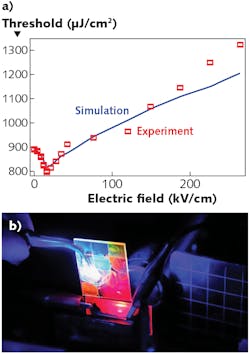Quantum-dot Emitters: Electrical pumping of quantum-dot lasers is possible
Colloidal quantum dots (CQDs), which are semiconductor nanoparticle light emitters that efficiently generate vivid and saturated colors, are being used more and more in electronic display screens. Although CQDs should be promising also as laser gain media, they are not yet practical because, so far, they have needed to be powered via optical pumping, thus rendering them too bulky and costly for use in semiconductor electronics.
Over the last few years, researchers have tried various approaches to make it easy to use CQDs in electrically pumped lasers, including electrochemical methods and chemical doping. These approaches require the use of harsh chemical solvents or oxygen-free environments in their production, and so have been limited to lab-scale experiments.
Now, scientists from Nanyang Technological University, Singapore (NTU Singapore) have developed a way to make CQDs produce laser light with the help of an electric field. NTU assistant professor Steve Cuong Dang and PhD student Yu Junhong have shown that an electric field can help CQDs emit laser light while using only a fraction of the energy traditionally required to drive a laser.1 In their experiments, the NTU scientists embedded CQDs between two electrodes, providing an electric field to control and change the properties inside the CQDs. By manipulating these properties, the scientists lowered the energy threshold needed for lasing by around 10%, bringing the prospect of CQD lasers closer to reality.
This threshold reduction is the first time researchers have lowered it using an electric field, instead of difficult-to-use electrochemical methods. Being able to build single-material low-cost compact lasers that are electrically driven in a wide range of colors is the holy grail for many optical and optoelectronic researchers. Lasers are the backbone technology for various industries including medical, security and consumer electronics, and are of interest for laser-based television displays.
CQDs are easily and economically produced in simple liquid-phase chemical syntheses, and their optical and electronic properties can be altered and controlled by varying the particle size. Colloidal nanomaterials are attractive to laser makers due to their low cost, tunable emission color, and high emission efficiency. However, getting them to lase currently requires fast, intense and coherent optical pumping, whereas electric pumping is slow, weak and incoherent.
Reducing Auger recombination
Ordinarily, CQDs require multiple excitons to achieve lasing, due to a so-called band-edge state degeneracy. This leads to Auger recombination, which is a nonradiative decay pathway that ends up raising the lasing threshold. But the researchers found that negative charging of the CQDs partially fills the conduction band, reducing the Auger recombination rate and lowering the amplified spontaneous emission (ASE) threshold by 10% if 17% of the CQDs are charged. A kinetics model of the process developed by the researchers agrees well with the experimental results (see figure).
The researchers used cadmium selenide/cadmium sulfide/zinc sulfide (CdSe/CdS/ZnS) core-shell-shell CQDs that have a photoluminescence peak at about 640 nm when optically pumped at 532 nm. An electric field in the CQDs is induced via a 128 Hz sinusoidal electrical bias. Dang worked with collaborators Hilmi Volkan Demir and Wang Hong from the School of Electrical and Electronic Engineering, and Sum Tze Chien from the School of Physical and Mathematical Sciences.
“The next big challenge in laser research is to develop nanoscale lasers and integrate them into on-chip photonic devices and ultrasensitive sensors,” says Demir. “This would bring significant impacts to modern society, especially in data and information processing, that is driving the fourth industrial revolution.”
If the charging process for an entire CQD film can be adequately controlled, continuous-wave (CW) or electrically driven devices could be possible. The team is now looking into making CQD lasers on a chip and is working with industry partners interested in developing the technology into proof-of-concept devices with practical applications.
REFERENCE
1. J. Yu et al., Sci. Adv. (2019); doi:10.1126/sciadv.aav3140.

John Wallace | Senior Technical Editor (1998-2022)
John Wallace was with Laser Focus World for nearly 25 years, retiring in late June 2022. He obtained a bachelor's degree in mechanical engineering and physics at Rutgers University and a master's in optical engineering at the University of Rochester. Before becoming an editor, John worked as an engineer at RCA, Exxon, Eastman Kodak, and GCA Corporation.
